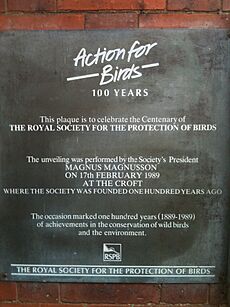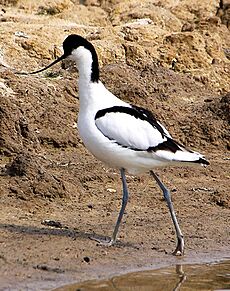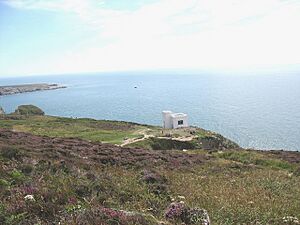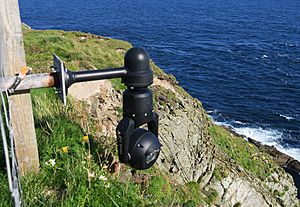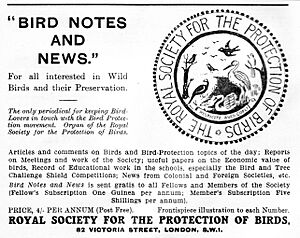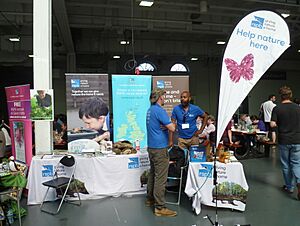Royal Society for the Protection of Birds facts for kids
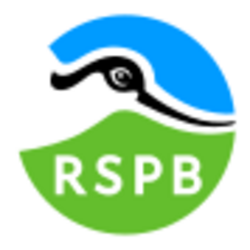 |
|
| Formation | 1889, Fletcher Moss Botanical Garden, Manchester |
|---|---|
| Type | Conservation charity |
| Headquarters | The Lodge, Sandy, Bedfordshire, England 2 Lochside View, Edinburgh, Scotland |
|
Area served
|
United Kingdom |
|
President
|
Dr Amir Khan |
|
Key people
|
|
|
Revenue
|
|
|
Staff (2022)
|
2,231 |
|
Volunteers (2022)
|
10,500 |
The Royal Society for the Protection of Birds (RSPB) is a charity in the United Kingdom. It started in 1889. The RSPB works to protect birds and the natural world. They do this by running campaigns, asking for new laws, and looking after nature reserves across the UK.
The RSPB is one of the biggest wildlife groups in the world. In 2022, they had over 1.1 million members, including many young people. They also had 2,200 staff and 10,500 volunteers. The RSPB has many local groups and manages 222 nature reserves.
How the RSPB Started
The RSPB began in 1889 thanks to two groups of women:
- The Plumage League was started by Emily Williamson in Manchester. They protested against using bird feathers in hats.
- The Fin, Fur and Feather Folk was started in Croydon by Eliza Phillips and others.
These groups became very popular. In 1891, they joined together to form the Society for the Protection of Birds in London. In 1904, the Society was given a special Royal Charter. This meant it had official recognition from the King.
The first members were all women. They campaigned against the fashion of wearing exotic feathers in hats. This fashion led to many birds being hunted. The Society had two simple rules for its members:
- Members should stop the needless killing of birds and help protect them.
- Lady-Members should not wear feathers from birds killed for fashion. Ostrich feathers were allowed because ostriches are farmed for their feathers.
At that time, the feather trade was huge. For example, in early 1884, almost 7,000 bird-of-paradise skins were brought into Britain. Hundreds of thousands of other birds were also imported.
In 1890, the Society published its first leaflet. It was called Destruction of Ornamental-Plumaged Birds. It aimed to save egrets by telling wealthy women about the harm caused by feather fashion. By 1898, the Society had 20,000 members.
Important women, like the Duchess of Portland, supported the Society. She became its first President. Many other important people, both men and women, also joined. The Society received its Royal Charter from King Edward VII in 1904. It also helped Parliament create laws to ban the use of feathers in clothing.
In 1961, the RSPB moved its main office to The Lodge in Sandy, Bedfordshire. The RSPB's logo shows an avocet, a type of bird.
What the RSPB Does Today
Today, the RSPB works with the government. They give advice on how to protect nature and the environment. They help decide which birds in the UK need special protection.
The RSPB does not run bird hospitals or rescue injured animals.
Nature Reserves
The RSPB looks after over 200 nature reserves across the UK. These places protect many different types of natural areas. They include estuaries, mudflats, forests, and even urban spaces. Many reserves have special hides for watching birds. They also have visitor centres with information about the wildlife.
Awards
The RSPB gives out awards to volunteers. These awards recognize people who have done great work for the Society.
RSPB Medal
The RSPB Medal is the highest award the Society gives. It is given to a person who has done amazing work to protect wild birds and the countryside. Usually, one or two people receive it each year.
Magazines
The RSPB has published magazines for its members for over 100 years.
Bird Notes
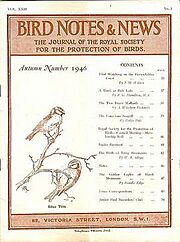
Cover of Autumn 1946 issue of Bird Notes, Vol. 23, No. 3
|
|
|
Abbreviated title (ISO 4)
|
Bird Notes |
|---|---|
| Discipline | Ornithology |
| Language | English |
| Publication details | |
| Publisher |
RSPB (United Kingdom)
|
|
Publication history
|
1903–1966 |
| Indexing | |
| ISSN | 0406-3392 |
Bird Notes and News was first published in April 1903. Its name changed to Bird Notes in 1947. In the 1950s, it came out four times a year. Many of the covers in the mid-1950s were drawn by Charles Tunnicliffe. The last edition of Bird Notes was published in late 1965.
Birds
|
Abbreviated title (ISO 4)
|
Birds |
|---|---|
| Discipline | Ornithology |
| Language | English |
| Edited by | Mark Ward |
| Publication details | |
| Publisher |
RSPB (United Kingdom)
|
|
Publication history
|
1966–2013 |
| Frequency | Quarterly |
| Indexing | |
| ISSN | 1367-983X |
| Links | |
|
|
Birds magazine took over from Bird Notes in January 1966. It was published four times a year. The last issue of Birds was in Autumn 2013.
Nature's Home
|
Abbreviated title (ISO 4)
|
Nat.'s Home |
|---|---|
| Discipline | Ornithology |
| Language | English |
| Edited by | Mark Ward |
| Publication details | |
| Publisher |
RSPB (United Kingdom)
|
|
Publication history
|
2013–present |
| Frequency | Quarterly |
| Indexing | |
| ISSN | 2054-3433 |
| Links | |
|
|
In Winter 2013, Birds was replaced by a new magazine called Nature's Home. Mark Ward was the editor.
The RSPB Magazine
Since Summer/Autumn 2022, the magazine has been called The RSPB Magazine.
Groups for Young People
The RSPB has special groups for children and teenagers:
- Wildlife Explorers is for children aged 8 to 12, but younger kids can join too. They have two magazines: Wild Times (for ages 0–7) and Wild Explorer (for ages 8–12). This group used to be called the Young Ornithologists' Club (YOC).
- RSPB Phoenix is for teenagers. They produce Wingbeat magazine, which is mostly written by young people.
Big Garden Birdwatch
The RSPB organizes the Big Garden Birdwatch every year. This is a huge event where people in Britain count the birds in their gardens. The RSPB calls it the "world's biggest wildlife survey." It helps experts understand how bird numbers are changing.
The Big Garden Birdwatch started in 1979 as an activity for children. From 2001, adults were also encouraged to take part. In 2011, over 600,000 people joined in. This event usually happens on the last weekend of January. Since the survey began, the number of house sparrows has dropped by 60%. Starling numbers have gone down by about 80% between 1979 and 2012.
In 2022, almost 700,000 people took part. They counted more than 11 billion birds!
BirdTrack
BirdTrack is an online project where people can record their bird sightings. It is run by the British Trust for Ornithology (BTO) and other groups, including the RSPB.
How the RSPB is Funded
The RSPB gets most of its money from its members. In 2006, over half of its income came from membership fees, donations, and money left in wills. This money is used for conservation projects, looking after nature reserves, and education programs.
Important People at the RSPB
Patrons
- Queen Elizabeth II (until 2022)
- King Charles III (since 2024)
Presidents
- Winifred Cavendish-Bentinck, Duchess of Portland 1891–1954
- Cyril Hurcomb
- Colonel Sir Tufton Beamish
- Derek Barber, Baron Barber of Tewkesbury
- Robert Dougall
- Max Nicholson 1980–1985
- Magnus Magnusson 1985–1990
- Sir Derek Barber 1990–1991
- Ian Prestt 1991–1994
- Julian Pettifer 1994–?
- Jonathan Dimbleby 2001–?
- Julian Pettifer 2004–2009
- Kate Humble 2009–2013
- Miranda Krestovnikoff 2013–2022
- Dr Amir Khan 2022–(current)
Chief Officers
The main leaders of the RSPB have had different job titles over the years.
- William Henry Hudson – Chairman of Committee 1894
- Sir Montagu Sharpe, KBE DL – Chairman of Committee 1895–1942
- Phillip Brown
- Peter Conder OBE – Secretary 1963. Director 1964–1975
- Ian Prestt CBE – Director General 1975–1991
- Barbara Young – CEO 1991–1998
- Sir Graham Wynne – CEO 1998–2010
- Mike Clarke – Chief Executive 2010–2019
- Beccy Speight - Chief Executive 2019–(current)
Other Groups the RSPB Works With
The RSPB is part of Wildlife and Countryside Link. It is also the UK partner of BirdLife International.
See also
 In Spanish: Royal Society for the Protection of Birds para niños
In Spanish: Royal Society for the Protection of Birds para niños
- List of Birdlife International national partner organisations
- Royal Society for the Prevention of Cruelty to Animals
- National Trust for Places of Historic Interest or Natural Beauty
- Wildlife law in England and Wales
- Category:Royal Society for the Protection of Birds reserves


